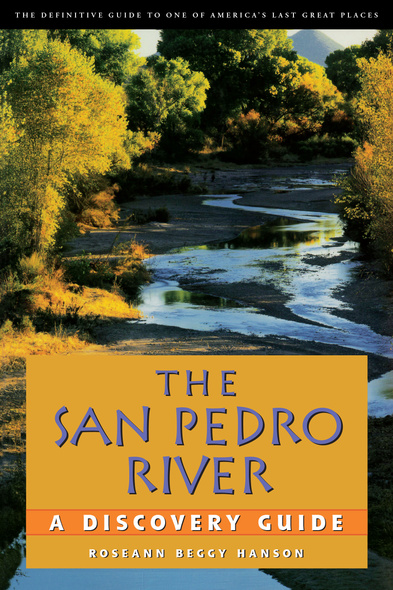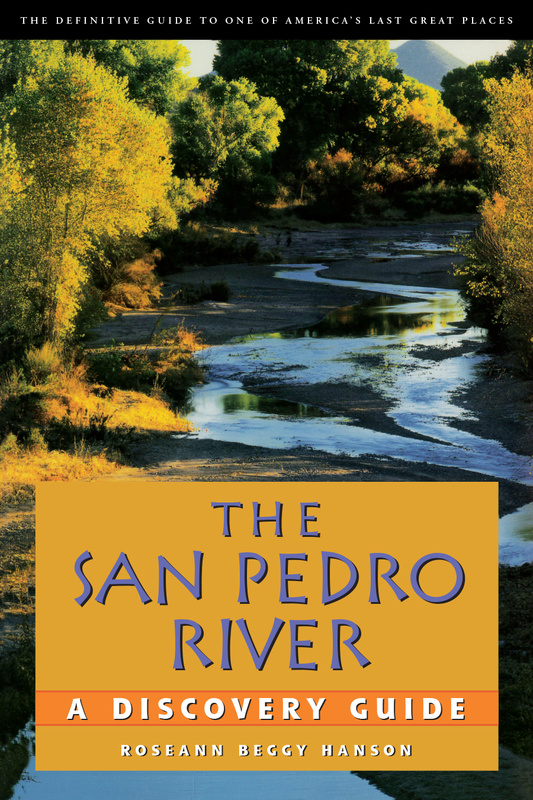The San Pedro River in southeastern Arizona not only features some of the richest wildlife habitat in the Southwest, it also is home to more kinds of animals than anywhere else in the contiguous United States. Here you'll find 82 species of mammals, dozens of different reptiles and amphibians, and nearly 400 species of birds—more than half of those recorded in the entire country. In addition, the river supports one of the largest cottonwood-willow forest canopies remaining in Arizona. It's little wonder that the San Pedro was named by the Nature Conservancy as one of the Last Great Places in the Northern Hemisphere, and by the American Bird Conservancy as its first Important Bird Area in the United States.
Roseann Hanson has spent much of her life exploring the San Pedro and its environs and has written a book that is both a personal celebration of and a definitive guide to this, the last undammed and unchanneled river in the Southwest. Taking you from the San Pedro's entry into the U.S. at the Mexican border to its confluence with the Gila River about a hundred miles north, she devotes a separate chapter to each of seven sections of river. Each chapter contains an eloquent essay on natural and cultural history, laced with Hanson's own experiences, plus an exploration guide brimming with useful information: how to get to the river, finding hiking trails, camping and other accommodations, birdwatching tips, access to biking and horseback riding, and nearby historic sites. Maps are included for each stretch of river, and the text is illustrated throughout with drawings from Roseann's copious field notebooks. Along the 40 miles of the San Pedro Riparian National Conservation Area, a sanctuary protected by the Bureau of Land Management since 1988, Hanson shows how the elimination of cattle and off-road vehicles has restored the river corridor to a more natural condition. She tells of the impact of humans on the San Pedro, from Clovis hunters to American settlers to Washington bureaucrats, and shows how, as the river winds its way north, it is increasingly threatened by groundwater pumping and urbanization.
In addition to the "discovery" sections of each chapter, Hanson has included species checklists for habitats and plants, birds, mammals, and reptiles and amphibians to make this a perfect companion for anyone exploring the area, whether as occasional tourist or frequent visitor. The book's blending of graceful prose and practical information shows that a river is the sum of many parts. Roseann Hanson will give you a special understanding—and perhaps a sense of stewardship—of this wild place.
Roseann Hanson has spent much of her life exploring the San Pedro and its environs and has written a book that is both a personal celebration of and a definitive guide to this, the last undammed and unchanneled river in the Southwest. Taking you from the San Pedro's entry into the U.S. at the Mexican border to its confluence with the Gila River about a hundred miles north, she devotes a separate chapter to each of seven sections of river. Each chapter contains an eloquent essay on natural and cultural history, laced with Hanson's own experiences, plus an exploration guide brimming with useful information: how to get to the river, finding hiking trails, camping and other accommodations, birdwatching tips, access to biking and horseback riding, and nearby historic sites. Maps are included for each stretch of river, and the text is illustrated throughout with drawings from Roseann's copious field notebooks. Along the 40 miles of the San Pedro Riparian National Conservation Area, a sanctuary protected by the Bureau of Land Management since 1988, Hanson shows how the elimination of cattle and off-road vehicles has restored the river corridor to a more natural condition. She tells of the impact of humans on the San Pedro, from Clovis hunters to American settlers to Washington bureaucrats, and shows how, as the river winds its way north, it is increasingly threatened by groundwater pumping and urbanization.
In addition to the "discovery" sections of each chapter, Hanson has included species checklists for habitats and plants, birds, mammals, and reptiles and amphibians to make this a perfect companion for anyone exploring the area, whether as occasional tourist or frequent visitor. The book's blending of graceful prose and practical information shows that a river is the sum of many parts. Roseann Hanson will give you a special understanding—and perhaps a sense of stewardship—of this wild place.
Selected as one of the best environmental books for 2001 by planeta.com
'Along with tons of information, including maps, trails, archaeological sites and a bird-species list, the book is a pleasure to read, thanks to a narrative style that'll make you want to grab your binoculars and go searching for the elusive Rufous-Backed Robin.'—Phoenix Magazine
'Raptor biologists and hawk watchers, along with ornithologists, birders, and naturalists will find this readable book an excellent introduction to the rich biodiversity, natural history, and history of this part of northern Mexico and the American Southwest.'—International Hawkwatcher
'Purchasing this guidebook to the San Pedro River is like buying two books in one. First, you get a book that can help plan a trip to one of America's 'Last Great Places.' . . . However, the second book within this book is the more endearing. In each chapter, Ms. Hanson vividly describes her experiences along the river and uses her stories as an avenue to educate the reader.'—North American Bird Bander
'An engaging combination of story and information and a sense of place that goes well beyond just what birds you might find . . . Read this book for pleasure. By the time you are through, you might, as I did, think that the next time you visit southeast Arizona you just might forego some of the hotspots for a rarer, richer experience.'—Bird Watcher's Digest
Roseann Hanson is Executive Director of the Sky Island Alliance, a Tucson-based nonprofit conservation group that works to protect and restore native habitat and species in the sky island region of southwestern New Mexico, southeastern and west-central Arizona, and northern Mexico.






